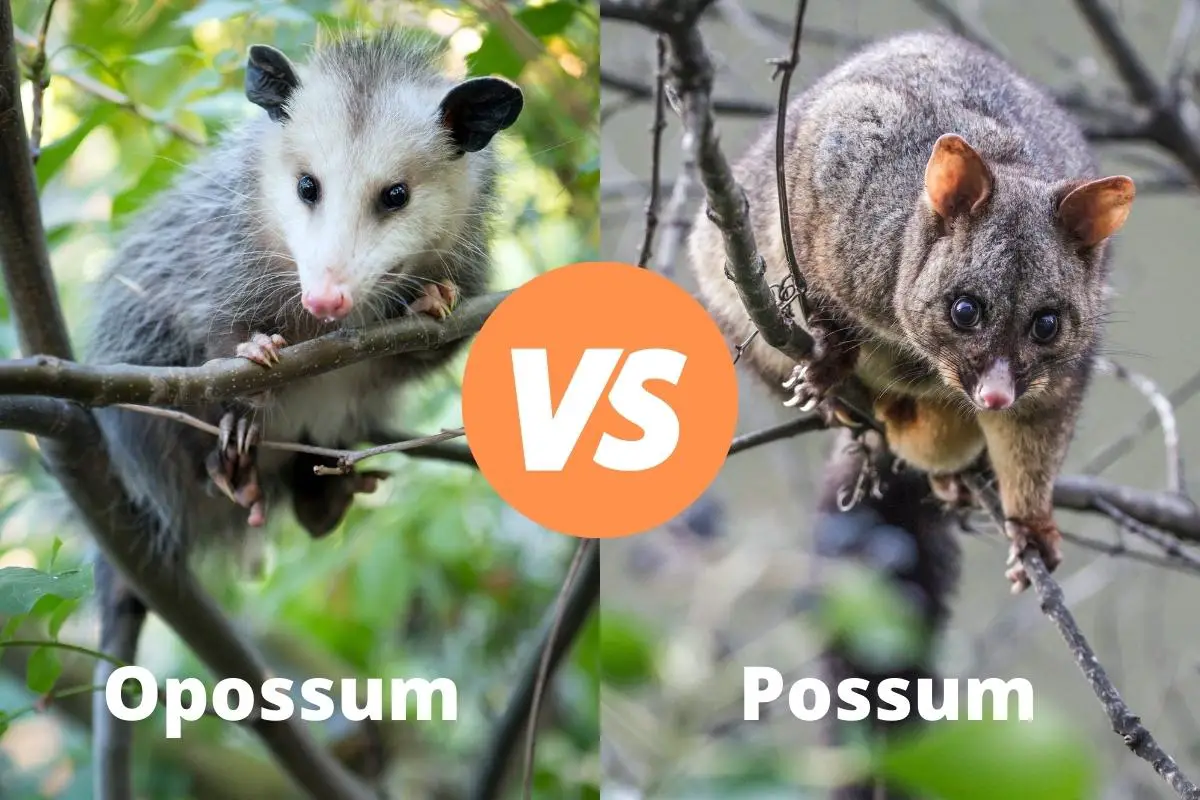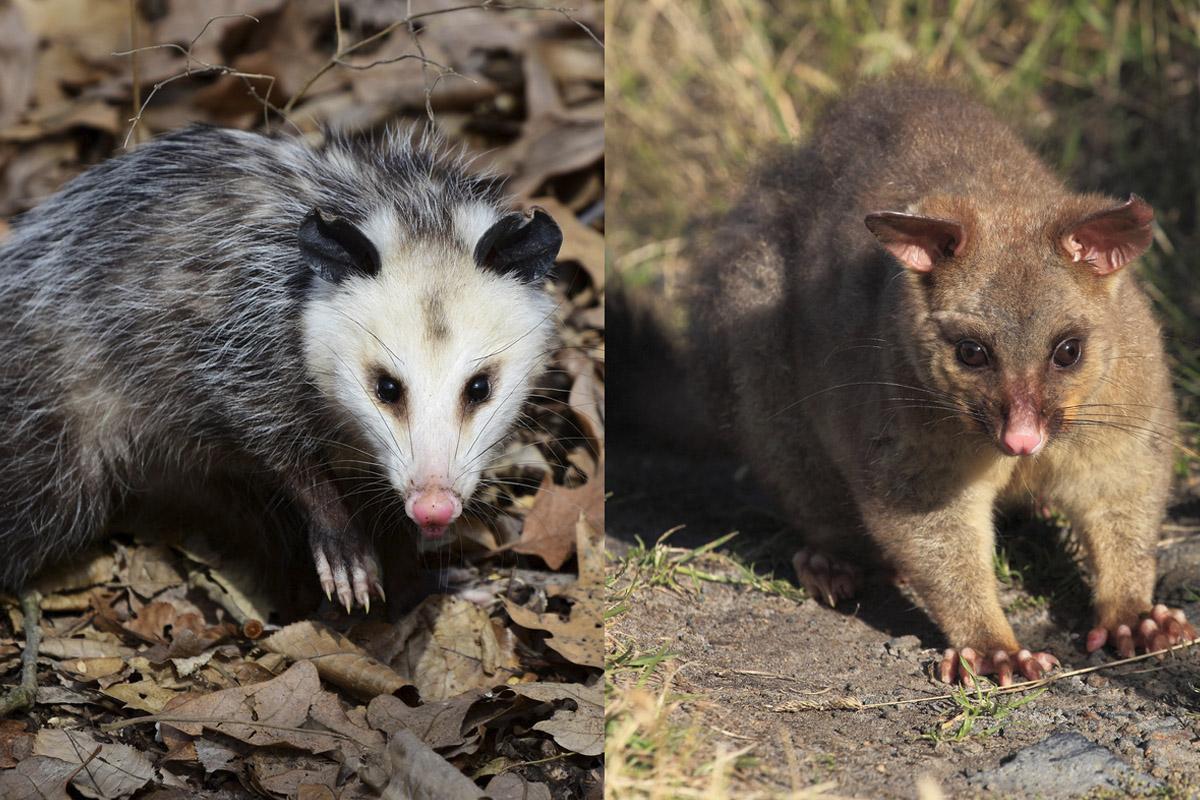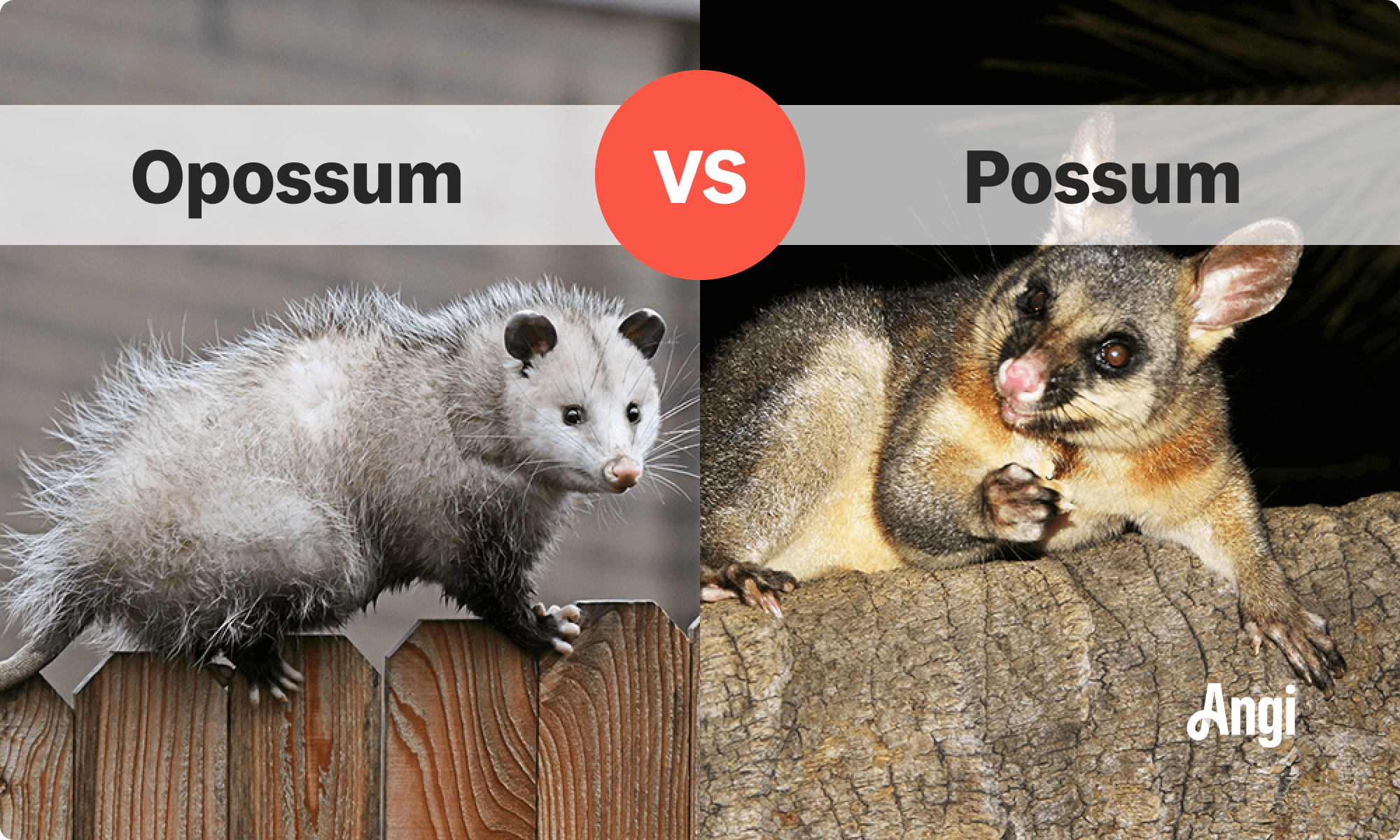Possum Vs Opossum - Unraveling The Marsupial Mystery
Have you ever found yourself wondering about that furry creature scurrying across your yard late at night, perhaps with a long, bare tail? Was it a possum or an opossum? It's a really common question, and honestly, the names sound so much alike, it's easy to get them mixed up. People often use the words interchangeably, but in fact, these two animals, while both marsupials, are quite separate beings with their own distinct characteristics. It's a little bit like calling a dolphin a fish; they both live in the water, but they're fundamentally different creatures, you know?
So, you might have heard someone say "possum" when they were talking about the one that lives in North America, or maybe they were referring to the ones that call Australia home. The truth is, there are some pretty clear ways to tell them apart, even though they share that general "pouch-carrying mammal" classification. We're going to clear up all that confusion, helping you figure out which animal is which, and why those differences matter. It's actually kind of fascinating, how two animals with such similar names can be so different, wouldn't you say?
And what about that famous phrase, "playing possum?" What does that even mean, and which of these creatures is known for it? If you've got questions about the real deal with possum versus opossum, how to tell them apart, or what they're actually like, you're in the right spot. We're going to walk through the main ways these animals are distinct, so you'll be able to spot the differences and even, perhaps, correct your friends in a friendly way. It's really just a matter of knowing a few key things, and we'll get into that right away.
Table of Contents
- What's the Real Difference Between Possum and Opossum?
- Where Do Possums and Opossums Live?
- How Do They Look Different - Possum and Opossum Physical Traits?
- What About "Playing Possum" - Behavioral Differences?
What's the Real Difference Between Possum and Opossum?
When people talk about a "possum" or an "opossum," they're often thinking of the same animal, but as a matter of fact, these are two entirely separate groups of creatures. While they both carry their young in a pouch, which makes them marsupials, their family trees actually split a very long time ago. It's kind of like how a cat and a tiger are both felines, but you wouldn't confuse them, right? The core message here is that despite the similar-sounding names, these animals are not just different species; they belong to completely different biological groupings, which is really quite interesting.
So, the primary distinction, the one that zoologists would point to first, is their scientific classification. Both are indeed marsupials, which means they're mammals that typically carry their young in a pouch. However, they belong to different orders, which is a very broad category in the way scientists organize life. It's almost like saying they're from different continents of the animal kingdom, even though they share a common ancestor way, way back. This is a fundamental point that helps us tell them apart, you know, on a deeper level than just how they look.
One group, the opossums, fall into an order called Didelphimorphia. These are the ones you're likely to see if you live in the Americas. Then, you have the possums, which are part of the Diprotodontia order. This second group includes many of Australia's well-known marsupials, like kangaroos and koalas, so you can see they're in pretty different company. It's just a way of categorizing them that shows how far apart their evolutionary paths have truly diverged. So, while they might seem similar to the casual observer, they're actually quite distinct, scientifically speaking, anyway.
Possum and Opossum Scientific Classifications
Let's talk a little more about those scientific names, because they really do tell a story about the possum versus opossum relationship. The Didelphimorphia order, where opossums sit, is an ancient group, and they are, in fact, the only marsupials that are native to North America. They've been around for millions of years, adapting to all sorts of environments across the Americas. So, when you see that creature with the long, pointed snout and bare tail in your backyard, it's almost certainly a member of this very old lineage. They are, in a way, living fossils of the marsupial world in the Western Hemisphere.
On the other hand, the possums, those in the Diprotodontia order, are entirely different. This order is a large and diverse group, pretty much exclusive to Australia and the nearby islands. It includes a whole bunch of iconic Australian animals, like the tree-dwelling koalas, the hopping kangaroos, and even the wallabies. So, when someone mentions a "possum" in Australia, they're thinking of a creature that shares a much closer family connection with these other unique Australian animals. It's a rather important distinction, as you can probably gather, because it places them on entirely separate branches of the marsupial family tree.
This difference in scientific classification means that while both possum and opossum carry their young in a pouch, their body structures, their habits, and even their diets have evolved along very different lines over millions of years. They've adapted to their own unique environments, which has led to the various physical and behavioral traits we see today. It's actually quite fascinating to think about how these two groups, both starting as marsupials, ended up so different simply because of where they lived and how their ancestors branched off, you know, so long ago.
Where Do Possums and Opossums Live?
One of the easiest ways to tell whether you're dealing with a possum or an opossum is simply to consider where you are on the planet. This geographical difference is a pretty clear indicator, and it helps cut through a lot of the confusion people have about these animals. If you're in North America, or even parts of South America, and you spot a marsupial, it's virtually guaranteed to be an opossum. They are the only marsupials that are truly native to these continents, which is a pretty unique fact about them.
Now, if you happen to be in Australia, or perhaps New Zealand or Papua New Guinea, and you see a creature that fits the general marsupial description, then you are almost certainly looking at a possum. These animals have made the Australian continent and its surrounding areas their home for ages. It's a bit like knowing that if you see a panda, you're probably in China, or if you see a kangaroo, you're definitely in Australia. The location really does narrow it down quite a lot, so that's a good starting point, anyway.
So, the next time you hear someone talking about seeing a "possum," your first question might be, "Oh, where were you?" Because if they say, "Oh, just in my backyard in Ohio," then you can pretty much know they saw an opossum, even if they called it a possum. And if they say they were traveling through the Australian bush, well, then it was a possum. It's a rather simple rule of thumb that helps sort out the possum versus opossum puzzle right away, you know, without even needing to see the animal itself.
Possum vs. Opossum - Native Lands
Let's expand a little on their native territories, because it's a key piece of the possum versus opossum story. The Virginia opossum, which is the one most people in North America are familiar with, has spread across a huge portion of the continent. You can find them from southern Canada all the way down through the United States and into Central America. They're incredibly adaptable, which is why they've managed to thrive in so many different environments, from forests to urban areas. They're quite resilient, actually, and have made themselves at home in a lot of places where humans live.
In contrast, the many species of possums (and there are quite a few different kinds!) are strictly found in Australasia. They occupy a wide range of habitats there, from dense rainforests to dry woodlands, and even city parks. Some possums, like the common brushtail possum, are very much at home in Australian cities, just like opossums are in American towns. It's pretty interesting, in a way, how both groups have found ways to live alongside humans in their respective parts of the world, isn't it?
This geographical separation means that these two groups of animals have evolved in complete isolation from each other for millions of years. They haven't had any direct interaction, which has allowed them to develop their own unique traits without any overlap. So, while both possum and opossum might look superficially similar to some people, their entire evolutionary history and ecological roles are tied to their distinct native lands. It's a really clear boundary, so that's a big help in telling them apart, you know, where they come from.
How Do They Look Different - Possum and Opossum Physical Traits?
Beyond where they live, there are some pretty noticeable physical differences between a possum and an opossum, if you get a good look at them. The North American opossum, for instance, typically has a rather pointed face, kind of like a long snout, and very prominent, hairless ears. Their tails are also quite distinctive: long, scaly, and mostly bare, almost like a rat's tail. They use these tails for gripping branches, which is pretty useful for climbing. Their fur tends to be a grizzled gray or white, and it can look a bit coarse, frankly.
Australian possums, on the other hand, generally have a much softer, more rounded face, which some people find quite appealing. Their ears are usually smaller and often covered with fur, giving them a more "cuddly" appearance, in some respects. Their tails are also prehensile, meaning they can grasp things, but many possum species have tails that are bushy or covered in fur, especially near the base, which makes them look quite different from their American counterparts. Their fur can come in a wider variety of colors, too, from shades of brown to black or even reddish tones, depending on the species, so that's a fairly good visual cue.
So, if you see an animal with a long, almost bald tail and a pointy nose, you're pretty much looking at an opossum. If the creature has a fluffy tail and a softer, rounder face, you're probably seeing a possum. These physical traits are a really helpful way to distinguish between the two, especially if you happen to be in a place where both names are used loosely. It's just a matter of paying a little attention to those details, and you'll be able to tell them apart, you know, pretty easily.
Possum and Opossum Physical Appearances
Let's break down some more of those visual cues that help separate the possum from the opossum. The Virginia opossum, which is the most common one, is about the size of a house cat, maybe a little larger. They have relatively short legs and five-toed feet, with an opposable thumb-like digit on their hind feet, which helps them climb. Their fur, as mentioned, is usually a sort of dingy gray, and it can look a bit shaggy. They also have those rather small, black eyes that can seem to reflect light in the dark, which is kind of eerie, but that's just how they are, you know.
When we look at Australian possums, there's quite a bit of variety, but many of them, like the common brushtail possum, are also roughly cat-sized, though some species are much smaller. The brushtail possum, for example, has large, oval-shaped ears that are covered in fur, and their tail is very bushy, especially at the base, tapering to a bare, prehensile tip. Their fur is often a lovely silver-gray, but can also be brown or black. Other possum species, like the ringtail possum, have even fluffier tails that they curl into a tight ring, which is pretty cute, actually. Their faces are generally more compact and less elongated than an opossum's, giving them a somewhat different overall look, so it's a bit like comparing different breeds of dogs, in a way.
These subtle differences in facial structure, ear covering, and tail appearance are really what sets them apart visually. While both possum and opossum might move with a similar slow, shuffling gait, and both might appear in your yard at night, taking a moment to observe these specific physical characteristics will give you the answer. It's just a matter of knowing what to look for, and then you'll be able to identify them accurately, you know, with confidence.
What About "Playing Possum" - Behavioral Differences?
Ah, "playing possum!" This is a phrase that has entered our everyday language, and it refers to a very specific behavior. It means pretending to be dead or unconscious to avoid danger, and it's a tactic most famously associated with the North American opossum. When these animals feel extremely threatened, their bodies can enter an involuntary state of shock. They literally collapse, their breathing becomes very shallow, their eyes glaze over, and they might even release a foul-smelling liquid from their anal glands, which makes them seem even more unappetizing to a predator. It's a pretty convincing act, actually, and it's not something they choose to do; it's a physiological response, so it's almost like fainting.
This "playing possum" behavior is a remarkable survival strategy. Most predators prefer to kill their prey themselves, and they're often put off by something that appears to be already dead or diseased. So, an opossum lying motionless and smelling bad is usually left alone, allowing it to recover and scurry away once the danger has passed. It's a rather clever defense mechanism, even if it's not a conscious decision on their part. This behavior is very characteristic of the opossum, and it's one of the most well-known things about them, you know, in popular culture.
While some Australian possum species might freeze or try to hide when threatened, they don't typically exhibit the same dramatic, involuntary "playing dead" response that opossums do. Their defense mechanisms are usually more about climbing quickly to safety, or sometimes, if cornered, they might hiss or make a loud noise to try and scare off a threat. So, if you ever see an animal truly "playing possum," completely still and seemingly lifeless, you can be pretty sure you're looking at an opossum. It's a unique trait that really sets the opossum apart from its Australian namesakes, you know, behaviorally speaking.
Possum and Opossum Survival Tactics
Let's look a little deeper into the ways both possum and opossum handle tricky situations. The opossum's "playing possum" is just one part of their overall survival toolkit. They are also excellent climbers, using their prehensile tails and nimble feet to scale trees and fences, which helps them escape ground-based predators. They are also quite opportunistic feeders, meaning they'll eat almost anything, from fruits and insects to carrion and garbage. This adaptability in diet helps them survive in many different environments, which is a pretty useful trait, as a matter of fact, especially in human-populated areas.
Australian possums, depending on the species, also have their own ways of staying safe. Many of them are nocturnal, meaning they're active at night, which helps them avoid daytime predators. They are also incredibly agile climbers, spending a lot of their time in trees, where they can find shelter and food. Some possum species build nests in tree hollows or dense foliage, while others, like the brushtail possum, might even take up residence in roof cavities, which is kind of a common occurrence in Australian suburbs. Their diet can vary too, with some being mostly leaf-eaters, while others enjoy fruits, flowers, and insects. So, they're also quite good at finding what they need to live, you know, in their own habitats.
So, while both possum and opossum are masters of survival in their respective homes, their primary defense strategies differ significantly. The opossum's unique "playing possum" act is a standout, while Australian possums rely more on their climbing prowess and nocturnal habits. It's pretty clear that even though they share a common marsupial ancestry, their individual journeys have led them to develop very different, yet effective, ways of staying alive in the wild. This contrast in their behavior is another important piece of the puzzle when you're trying to understand the distinction between these two fascinating creatures, you know, in their natural settings.
This article has explored the key differences between possums and opossums, highlighting their distinct scientific classifications, geographical distributions across North America and Australia, and varied physical appearances. We also looked into their unique behavioral traits, including the well-known "playing possum" defense mechanism of the North American opossum, and compared it to the survival strategies of Australian possums. By understanding these points, you can now tell apart these two often-confused marsupial groups.

Opossum Vs Possum | The Ultimate Guide | Assorted Animals

Possum vs. Opossum: What's The Real Difference?

Possum vs. Opossum | Angi